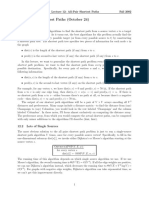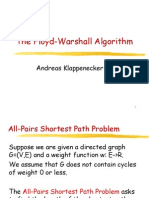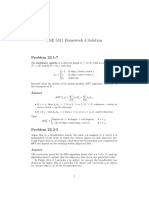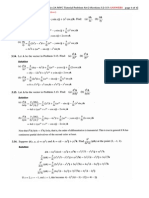Alg Lec25 Spt2 Print
Alg Lec25 Spt2 Print
Uploaded by
satryabagasCopyright:
Available Formats
Alg Lec25 Spt2 Print
Alg Lec25 Spt2 Print
Uploaded by
satryabagasCopyright
Available Formats
Share this document
Did you find this document useful?
Is this content inappropriate?
Copyright:
Available Formats
Alg Lec25 Spt2 Print
Alg Lec25 Spt2 Print
Uploaded by
satryabagasCopyright:
Available Formats
24.
1 The Bellman-Ford Algorithm
24.1 The Bellman-Ford Algorithm (continued)
Bellman Ford(G, w, s) 1 s. d = 0 2 s. = NIL 3 for all v V {s} 4 v. d = 5 v. = NIL 6 for i = 1 to |V | 1
7 8 9 10 11 12
The Bellman-Ford algorithm solves the single-source shortest paths problem. Unlike Dijkstras algorithm, it allows edges of negative length. The bad news is that it runs slower. Like Dijkstras algorithm, the Bellman-Ford algorithm uses the technique of relaxation, progressively decreasing estimates v. d of the distance from s until the estimates are precise. The algorithm returns true iff the graph contains no negative cycles that are reachable from the source.
for each edge (u, v) E Relax(u, v, w) if v. d > u. d + w(u, v) return false /* i.e., (u, v) can still be relaxed */
for each edge (u, v) E return true
The running time is O(V E ). COMP3600/6466: Lecture 25 2012 1 COMP3600/6466: Lecture 25 2012 2
24.1 The Bellman-Ford Algorithm (continued)
24.1 The Bellman-Ford Algorithm (continued)
Proof of correctness. As usual with relaxation, we always have v. d (s, v) and v. d can only decrease. A phase is one iteration of the for loop of lines 68, where each edge is relaxed once. (1) Suppose there is no negative cycle reachable from s. We can assume k |V | 1. Consider some shortest path s v1 v2 vk1 vk .
COMP3600/6466: Lecture 25 2012 3
When (s, v1) is relaxed in the 1st phase, v1. d is set to (s, v1) if it isnt already. When (v1, v2) is relaxed in the 2nd phase, v2. d is set to (s, v2) if it isnt already.
When (vk1, vk ) is relaxed in the kth phase, vk . d is set to (s, vk ) if it isnt already.
So v. d = (s, v) for all v after |V | 1 phases, and no edges are still relaxable. COMP3600/6466: Lecture 25 2012 4
24.1 The Bellman-Ford Algorithm (continued)
(2) Suppose there is a negative cycle reachable from s. Say the cycle is v0 v1 v2 vk = v0. After |V | 1 phases, all the v. d values on the cycle are nite. Suppose that none of the edges on the cycle are relaxable. That is,
24.2 Single-Source Shortest Paths in DAGs
For a directed graph without cycles (a DAG), we can get by with fewer relaxations. We relax the edges according to the increasing topological order of their start vertices.
Summing this inequality over i = 1, . . . , k, we nd a contradiction since the sum of w(vi1, vi) is negative by assumption. Therefore, some edge of the negative cycle is still relaxable.
vi. d vi1. d + w(vi1, vi)
for i = 1, . . . , k.
DAG Shortest Paths(G, w, s) 1 s. d = 0 2 s. = NIL 3 for all v V {s} 4 v. d = 5 v. = NIL 6 for each vertex u in topological order 7 for v G. Adj [u] 8 Relax(u, v, w)
The time complexity is O(V + E ). 5 COMP3600/6466: Lecture 25 2012 6
Note that fewer than |V | 1 phases may not be enough. COMP3600/6466: Lecture 25 2012
24.2 Shortest Paths in DAGs (continued)
24.2 Shortest Paths in DAGs (continued)
Proof of correctness. Consider any shortest path s v1 v2 vk1 vk . The algorithm relaxes the edges from left to right.
When (s, v1) is relaxed, v1. d is set to (s, v1) if it isnt already. When (v1, v2) is relaxed, v2. d is set to (s, v2) if it isnt already.
When (vk1, vk ) is relaxed, vk . d is set to (s, vk ) if it isnt already.
So v. d = (s, v) for all v by the time we are nished.
COMP3600/6466: Lecture 25
2012
COMP3600/6466: Lecture 25
2012
24.4 Difference constraints
Suppose we have to schedule n tasks T1, T2, . . . , Tn, and we have a set of constraints like these:
24.4 Difference constraints (continued)
T3 must be done at least 15 minutes after T7 T2 must be done before T9 T2 must be done at least 5 minutes before T4 T5 must be done at most 10 minutes after T1
and so on. We wish to know if this is possible and if so nd a schedule. If Ti is scheduled at time xi, the above constraints can be written as:
In general, we have real variables x1, x2, . . . , xn, and some number of constraints of the form x j xi bk . We will dene a weighted graph G = (V , E , w), called the constraint graph. There are n + 1 vertices V = {v0, v1, v2, . . . , vn}. There is an edge (v0, vi) of length 0 for i = 1, 2, . . . , n. For each constraint x j xi bk , there is an edge (vi, v j ) with length bk . Interesting fact: If the constraint graph has a negative cycle, there is no solution. Otherwise, an example of a solution is
x7 x3 15 x2 x9 0 x2 x4 5 x5 x1 10
COMP3600/6466: Lecture 25 2012 9
xi = (v0, vi) for i = 1, 2, . . . , n.
COMP3600/6466: Lecture 25
2012
10
24.4 Example system of difference constraints
24.4 Example constraint graph and solution
x1 x2 0, x1 x5 1, x2 x5 1, x3 x1 5, x4 x1 4, x4 x3 1, x5 x3 3, x5 x4 3.
(1) (2) (3) (4) (5) (6) (7) (8)
COMP3600/6466: Lecture 25
2012
11
COMP3600/6466: Lecture 25
2012
12
You might also like
- The Seven PrinciplesDocument3 pagesThe Seven PrinciplesPunyaja SwaroopNo ratings yet
- ECE 476 Power System AnalysisDocument36 pagesECE 476 Power System AnalysisFady MichealNo ratings yet
- Bellman FordDocument9 pagesBellman FordIstiaque AhmedNo ratings yet
- FEM For 2D With MatlabDocument33 pagesFEM For 2D With Matlabammar_harbNo ratings yet
- Optional Rotary Drilling Rig & Construction MethodDocument49 pagesOptional Rotary Drilling Rig & Construction MethodLinzaw WinNo ratings yet
- Mit Fall 2010 Bellman FordDocument5 pagesMit Fall 2010 Bellman Fordjuliejoe122jjNo ratings yet
- Shortest Paths II: Bellman-Ford, Topological Sort, DAG Shortest Paths, Linear Programming, Difference ConstraintsDocument23 pagesShortest Paths II: Bellman-Ford, Topological Sort, DAG Shortest Paths, Linear Programming, Difference ConstraintsYashashavi LadhaNo ratings yet
- Design and Analysis of Algorithms: CSE 5311 Lecture 21 Single-Source Shortest PathsDocument48 pagesDesign and Analysis of Algorithms: CSE 5311 Lecture 21 Single-Source Shortest Pathsshashank dwivediNo ratings yet
- אלגוריתמים- הרצאה 7 - Single Source Shortest Path ProblemDocument5 pagesאלגוריתמים- הרצאה 7 - Single Source Shortest Path ProblemRonNo ratings yet
- ITCS 6114: Single-Source Shortest PathDocument54 pagesITCS 6114: Single-Source Shortest PathERIC CONDENo ratings yet
- Chapter 24: Single-Source Shortest Paths: GivenDocument48 pagesChapter 24: Single-Source Shortest Paths: GivenNaveen KumarNo ratings yet
- 12 ApspDocument6 pages12 ApspseemasuranaNo ratings yet
- Design and Analysis of Algorithms CO 401: Ash Mohammad AbbasDocument18 pagesDesign and Analysis of Algorithms CO 401: Ash Mohammad AbbasMohd Nafees AnsariNo ratings yet
- Graph Theory Assignment 4Document5 pagesGraph Theory Assignment 4gixiNo ratings yet
- E-Note 19716 Content Document 20240513011047PMDocument84 pagesE-Note 19716 Content Document 20240513011047PMrahulfha673No ratings yet
- 24 - Single-Source Shortest PathsDocument55 pages24 - Single-Source Shortest Pathstwzfpdwg6kNo ratings yet
- Lecture 17: Shortest Paths III: Bellman-FordDocument6 pagesLecture 17: Shortest Paths III: Bellman-FordIoannis FrangisNo ratings yet
- The Floyd-Warshall Algorithm: Andreas KlappeneckerDocument15 pagesThe Floyd-Warshall Algorithm: Andreas KlappeneckeranantbaraNo ratings yet
- CS341 Lec14 Annotated Mar14Document67 pagesCS341 Lec14 Annotated Mar14artemNo ratings yet
- Lecture 22 (Floyd and Warshal)Document16 pagesLecture 22 (Floyd and Warshal)avinashNo ratings yet
- Manual For Instructors: TO Linear Algebra Fifth EditionDocument10 pagesManual For Instructors: TO Linear Algebra Fifth EditionMuhammad Umer ShahNo ratings yet
- TSP Various FormulationsDocument4 pagesTSP Various Formulationsarunss9890No ratings yet
- Student Handout 14 2014Document18 pagesStudent Handout 14 2014kietniNo ratings yet
- Lecture 22 (Floyd and Warshal)Document16 pagesLecture 22 (Floyd and Warshal)Sakshi MauryaNo ratings yet
- 07 Shortest Path AlgorithmsDocument18 pages07 Shortest Path AlgorithmsahmNo ratings yet
- Seminar On Causality The SGS-and The PC-Algorithm: Alexandra Federer, Moritz D Umbgen Monday, March 23, 2009Document6 pagesSeminar On Causality The SGS-and The PC-Algorithm: Alexandra Federer, Moritz D Umbgen Monday, March 23, 2009Ramjet2222No ratings yet
- DijkstraDocument5 pagesDijkstraapi-3839714No ratings yet
- Lectures On Graph SeriesDocument50 pagesLectures On Graph SeriesShivam PandeyNo ratings yet
- Shortest Paths in A Graph (Cont'd) : Fundamental AlgorithmsDocument22 pagesShortest Paths in A Graph (Cont'd) : Fundamental AlgorithmsshailimishraNo ratings yet
- Backlund Transformation PDFDocument11 pagesBacklund Transformation PDFShaurya SethNo ratings yet
- Solutions 3Document4 pagesSolutions 3Hoang NguyenNo ratings yet
- Camino Mas CortoDocument17 pagesCamino Mas CortoDiego Muñoz CarrascoNo ratings yet
- Single Source Shortest PathsDocument17 pagesSingle Source Shortest PathsAnukul GangwarNo ratings yet
- Single-Source Shortest Paths (Ch. 24) Single-Source Shortest PathsDocument5 pagesSingle-Source Shortest Paths (Ch. 24) Single-Source Shortest PathsSharadakle CkleNo ratings yet
- 13 - Chapter 22Document42 pages13 - Chapter 22AlienNo ratings yet
- Bellman FordDocument10 pagesBellman Fordagrawal.anany1005No ratings yet
- Vector CalculusDocument8 pagesVector Calculusgthulasi789193No ratings yet
- Minimum K-CutDocument25 pagesMinimum K-CutLupu RazvanNo ratings yet
- ElmagDocument4 pagesElmagLukman HakimNo ratings yet
- CSE 5311 Homework 4 Solution: Problem 22.1-7Document5 pagesCSE 5311 Homework 4 Solution: Problem 22.1-7Prateek RaawatNo ratings yet
- Chapter 24: Single-Source Shortest Paths: GivenDocument48 pagesChapter 24: Single-Source Shortest Paths: GivenAnanya Lakshmi PNo ratings yet
- Power System Analysis: Transmission Line ModelsDocument33 pagesPower System Analysis: Transmission Line Modelsmohon_eee03No ratings yet
- MVC - AnswersDocument12 pagesMVC - AnswersJA55EENo ratings yet
- hw07 Solution PDFDocument7 pageshw07 Solution PDFsiddharth1kNo ratings yet
- Lecture 12 DijkstraDocument39 pagesLecture 12 DijkstraMostafizur RahamanNo ratings yet
- 05 CME4422 ShortestPathAlgorithmsDocument46 pages05 CME4422 ShortestPathAlgorithmsSAMET KEMAL ÖZDEMİRNo ratings yet
- All Pair Shortest PathDocument2 pagesAll Pair Shortest PathShivam MishraNo ratings yet
- Physics430 Lecture04Document22 pagesPhysics430 Lecture04Azwar SutionoNo ratings yet
- Wavelets MATLAB Assignment 5 5.1: Linear Convolution in MATLABDocument4 pagesWavelets MATLAB Assignment 5 5.1: Linear Convolution in MATLABTran TrongNo ratings yet
- 17 Shortest Paths IDocument59 pages17 Shortest Paths ITanmay BaranwalNo ratings yet
- Shortest Paths in A Graph: Fundamental AlgorithmsDocument28 pagesShortest Paths in A Graph: Fundamental AlgorithmsShivam PandeyNo ratings yet
- The Finite Element Method For 2D Problems: Theorem 9.1Document47 pagesThe Finite Element Method For 2D Problems: Theorem 9.1Anita RahmawatiNo ratings yet
- Notes On Weyl and Minkowski Problem: Yang Guo 260313651 September 6, 2011Document25 pagesNotes On Weyl and Minkowski Problem: Yang Guo 260313651 September 6, 2011Guo YangNo ratings yet
- 0eef690adf10b98bffd65d5415516412_lec18Document8 pages0eef690adf10b98bffd65d5415516412_lec18andreigabe07No ratings yet
- Solution For Chapter 22Document5 pagesSolution For Chapter 22Sveti JeronimNo ratings yet
- Algorithms and Computations Complexity: Single-Source Shortest PathsDocument12 pagesAlgorithms and Computations Complexity: Single-Source Shortest PathskhilNo ratings yet
- Seminar03 MPE TrussDocument6 pagesSeminar03 MPE TrussAndrei CioroianuNo ratings yet
- Unstable Pole-Zero Cancelled System: StableDocument15 pagesUnstable Pole-Zero Cancelled System: StableRavinder RangaNo ratings yet
- Laplace and Random NumbersDocument19 pagesLaplace and Random NumbersJohnson LiuNo ratings yet
- Green's Function Estimates for Lattice Schrödinger Operators and ApplicationsFrom EverandGreen's Function Estimates for Lattice Schrödinger Operators and ApplicationsNo ratings yet
- 002 ChangesDocument3 pages002 Changes郭哲宏No ratings yet
- SRP3A - MEB - RFI 0572 - MEB Anchor Plate Frictional Force - Response REV 1Document44 pagesSRP3A - MEB - RFI 0572 - MEB Anchor Plate Frictional Force - Response REV 1mirza.adeelNo ratings yet
- Operating Instructions: R2E220-AA40-23Document9 pagesOperating Instructions: R2E220-AA40-23Leszek PuchalaNo ratings yet
- FEC Standard: Hardware DescriptionDocument134 pagesFEC Standard: Hardware DescriptionikarosNo ratings yet
- Management of Hyperglycemia and Diabetes in The Emergency DepartmentDocument8 pagesManagement of Hyperglycemia and Diabetes in The Emergency DepartmentLizeth SaucilloNo ratings yet
- Specification Sheet Bolt-On Saddle Flow Meter Model: DescriptionDocument2 pagesSpecification Sheet Bolt-On Saddle Flow Meter Model: Descriptioncontrol1y1segu-65318No ratings yet
- GK AFCS - Proposal With Quotation For Pasig-Lrt Marikina Transport Service CooperativeDocument2 pagesGK AFCS - Proposal With Quotation For Pasig-Lrt Marikina Transport Service Cooperativebryan kent labitadNo ratings yet
- CES Business PresentationDocument50 pagesCES Business PresentationGary David CrowhurstNo ratings yet
- Motorola Driver LogDocument8 pagesMotorola Driver Logdaron792No ratings yet
- Business Marketing-Presentation On Mohammadi Group (RMG)Document17 pagesBusiness Marketing-Presentation On Mohammadi Group (RMG)Mehedi HassanNo ratings yet
- Excerpt From A Beautiful Mess Happy Handmade HomeDocument17 pagesExcerpt From A Beautiful Mess Happy Handmade HomeCrown Publishing Group100% (1)
- Sad 500 - Customs Declaration Form: KOM ADocument1 pageSad 500 - Customs Declaration Form: KOM Aalsone07No ratings yet
- Instruction Manual Fisher Fieldvue dvc6200 Sis Digital Valve Controller en 122736Document124 pagesInstruction Manual Fisher Fieldvue dvc6200 Sis Digital Valve Controller en 122736Gangsar DwikaNo ratings yet
- Indian Telegraph Act 1885 Part 3Document7 pagesIndian Telegraph Act 1885 Part 3Ramesh BabuNo ratings yet
- Chapter 15 - MINING MEANING FROM TEXTDocument20 pagesChapter 15 - MINING MEANING FROM TEXTSimer FibersNo ratings yet
- Adam A Chapter 4Document28 pagesAdam A Chapter 4davidNo ratings yet
- 2.1 RIMS Traffic Counting GuidelineDocument20 pages2.1 RIMS Traffic Counting GuidelineblackwellkidNo ratings yet
- Filum EchinodermataDocument15 pagesFilum EchinodermataForman SihombingNo ratings yet
- Sae J34-2018Document11 pagesSae J34-2018Gerardo FloresNo ratings yet
- The Best Control For Bed BugsDocument10 pagesThe Best Control For Bed BugsHowPawNo ratings yet
- Client Side and Server SideDocument3 pagesClient Side and Server Side10300 PEDDI KISHORNo ratings yet
- Academic Transcript Request: Personal DetailsDocument1 pageAcademic Transcript Request: Personal DetailsSyed OmerNo ratings yet
- Driving Quality and Safety in The Automotive Industry: ASTM StandardsDocument4 pagesDriving Quality and Safety in The Automotive Industry: ASTM StandardsPaurav MacwanNo ratings yet
- Connoisseur of Chaos: SchnittkeDocument6 pagesConnoisseur of Chaos: SchnittkeRobert MorrisNo ratings yet
- 3Document3 pages3youkosoo943No ratings yet
- UNIT 3, Sentence Structure - Categories - HandoutDocument38 pagesUNIT 3, Sentence Structure - Categories - HandoutQuỳnh NguyễnNo ratings yet
- Comprehensive PharmacologyDocument102 pagesComprehensive PharmacologyHailMarieSBarcenasNo ratings yet
- (Riccardo Viale, Fondazione Rosselli) The Capitali (B-Ok - CC) PDFDocument364 pages(Riccardo Viale, Fondazione Rosselli) The Capitali (B-Ok - CC) PDFmarceloamaralNo ratings yet

























































































